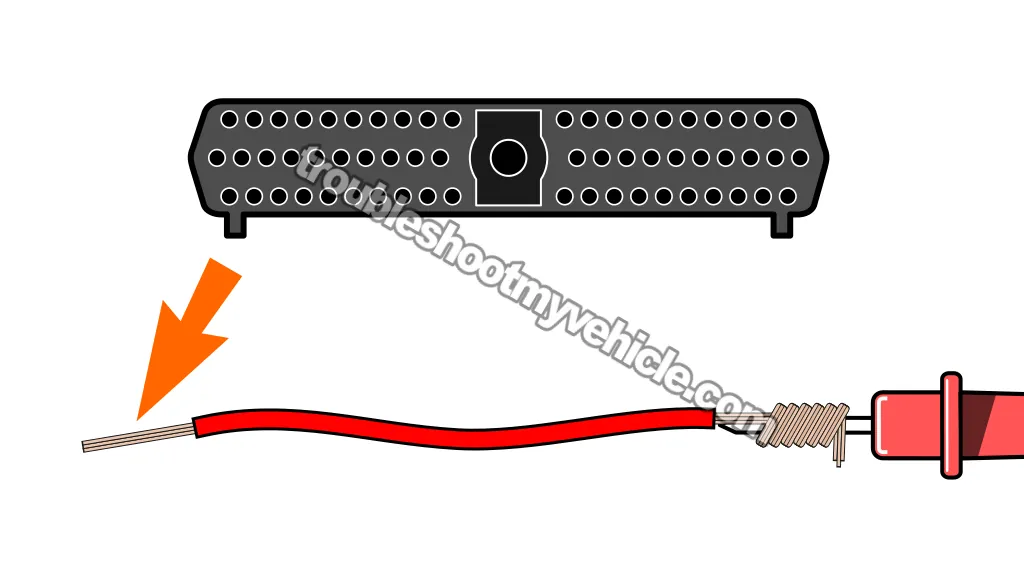
At some point, you'll face a diagnostic situation where you have to check continuity of a circuit (wire) between a sensor, solenoid, or control module and the PCM's 104-pin connector.
It's a common test —but if you don't use the right tool and technique, you can easily damage those delicate PCM terminals (or the connector itself).
In this guide, I'll walk you through safe, proven ways to test those circuits on your Ford Taurus or Mercury Sable without risking the PCM connector.
Contents of this tutorial:
APPLIES TO: This tutorial applies to the following vehicles:
- 3.8L V6 Ford Taurus: 1990, 1991, 1992, 1993, 1994, 1995.
- 3.8L V6 Mercury Sable: 1990, 1991, 1992, 1993, 1994, 1995.
What I Don't Do (And Why)
The Powertrain Control Module (PCM) on the 1990-1995 3.8L V6 Ford Taurus (Mercury Sable) is Ford's EEC-IV fuel injection computer, and it connects to the vehicle's wiring through a 60-pin weather-sealed connector.
This connector is built to handle heat, vibration, and specifically moisture —but it's also delicate in a few important ways you should know about.
Each wire entering the PCM connector passes through a tiny rubber seal before it attaches to a metal terminal inside. Those seals are there to keep moisture out and prevent corrosion on the metal terminals.
Inside the connector, the female terminals themselves are very small and can be damaged easily if the wrong test probe is used (when probing them from the front of the connector).
When you need to test continuity or voltage at the PCM connector, you have two basic options: probing from the back or from the front. Both come with risks.
- Back-probing: When you insert a back probe, it pierces the rubber seal to reach the terminal. That small hole lets moisture in, which eventually leads to corrosion and poor electrical contact.
- Front-probing: If the probe is too thick, it can spread or deform the terminal opening, causing weak or intermittent connections that are difficult to diagnose later.
So, what's the safe way to do it?
After years of testing circuits between PCM and component connectors, I've learned that front-probing can be done safely —but only with the right tools.
Precision automotive probes have ultra-thin tips that let you make contact without spreading or damaging the female terminals.
Personally, I use a wire-piercing probe kit with removable needle tips —perfect for testing directly at the PCM connector when I need accuracy and safety. You can see them here:
- Goupchn 4mm Banana to Banana Plug Test Leads Kit (Amazon affiliate link).
Here are some other kits that'll also do the job:
- AUTOOL 68PCS Multimeter Test Leads Kit (Amazon affiliate link).
- LUTIFIX 68PCS Automotive Circuit Test Leads Kit (Amazon affiliate link).
The only real drawback to precision probes is the cost —some (not all) can be pricey, and you'll usually need to order them online.
But honestly, that's nothing compared to the headache of damaging the PCM connector and ending up with a full wiring harness replacement.
It's one of those tools that pays for itself the first time it saves you from that mess —in the short and long term, the tool is worth every penny.
The Safe, Low-Cost Method I Use

I always recommend using precision probes with fine tips when testing the front of the PCM connector. But if you don't have any, there's still a safe workaround that's served me well for years.
All you need is a short piece of wire —strip both ends, slip one end into the female terminal, and wrap the other end around your multimeter lead. Simple, safe, and effective.
Now, here are the specifics of how to do it.
- Grab a small piece of scrap wire, about 3 to 4 inches long. I usually pull one from an old engine wiring harness, but any automotive-grade wire you've got lying around will do just fine.
- Strip about ½ to 1 inch of insulation off both ends of the wire.
- On one end, wrap the bare copper strands tightly around the metal tip of your multimeter lead. You want a good, solid connection here.
- Wrap a small strip of electrical tape around the test lead where the copper is wrapped.
- This keeps the connection tight and also insulates it, so the exposed wire doesn't accidentally touch metal and throw off your reading.
- On the other end, insert the bare copper into the PCM connector terminal (the same side the PCM plugs in —not the back).
- If the wire has too many strands to slide in cleanly, just trim a few off with wire cutters. You want it to go in with slight resistance, enough to make a good and solid contact.
This method gives you a clean, reliable connection to the PCM terminal with no risk of spreading or damaging it. When you're done testing, just pull the wire out and plug the connector back in like normal.
Always Disconnect The Battery Before Working On The PCM Connector
Before unplugging or reconnecting the PCM on your Ford Taurus, always disconnect the battery's negative (-) cable from the post first.
The PCM's internal circuits are extremely sensitive to voltage spikes and can be damaged in an instant if power is still present while you're plugging or unplugging the 60-pin connector. Even a tiny static charge spark could cause an internal failure, killing the PCM.
Now, there are times when you'll need the battery connected to perform specific tests —for example, when checking for power or voltage at certain PCM terminals. In those cases, it's perfectly fine to reconnect the battery as long as the PCM connector stays unplugged from the PCM itself.
Reconnecting the battery to the negative (-) cable —with the PCM already disconnected from its 60-pin connector— allows you to supply voltage to the circuit without putting the PCM itself at risk.
Once your tests are complete and you're ready to reconnect the PCM connector, always disconnect the negative (-) battery cable again before plugging it back in.
More 3.8L V6 Ford Taurus Diagnostic Tutorials
You can find a complete list of diagnostics tutorials for the 3.8L V6 Taurus in this index:
Here's a small sample of the tutorials you'll find in the index:
- How To Test The TPS With A Multimeter (1990-1995 3.8L V6 Taurus, Mercury Sable).
- How To Test The MAF Sensor (1991-1995 3.8L V6 Ford Taurus, Mercury Sable).
- How To Test For A Blown Head Gasket (1990-1995 3.8L V6 Ford Taurus, Mercury Sable).
- How To Test The Engine Compression (1990-1995 3.8L V6 Ford Taurus, Mercury Sable).

If this info saved the day, buy me a beer!

